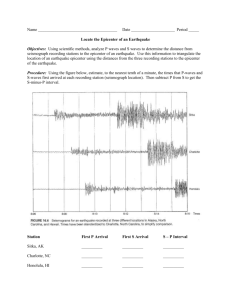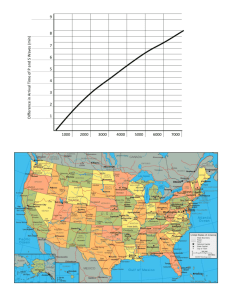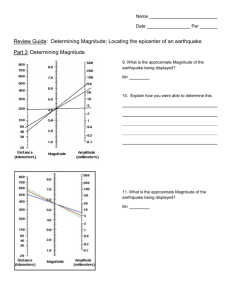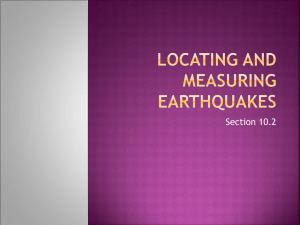Earthquake Gizmo Sheet
advertisement
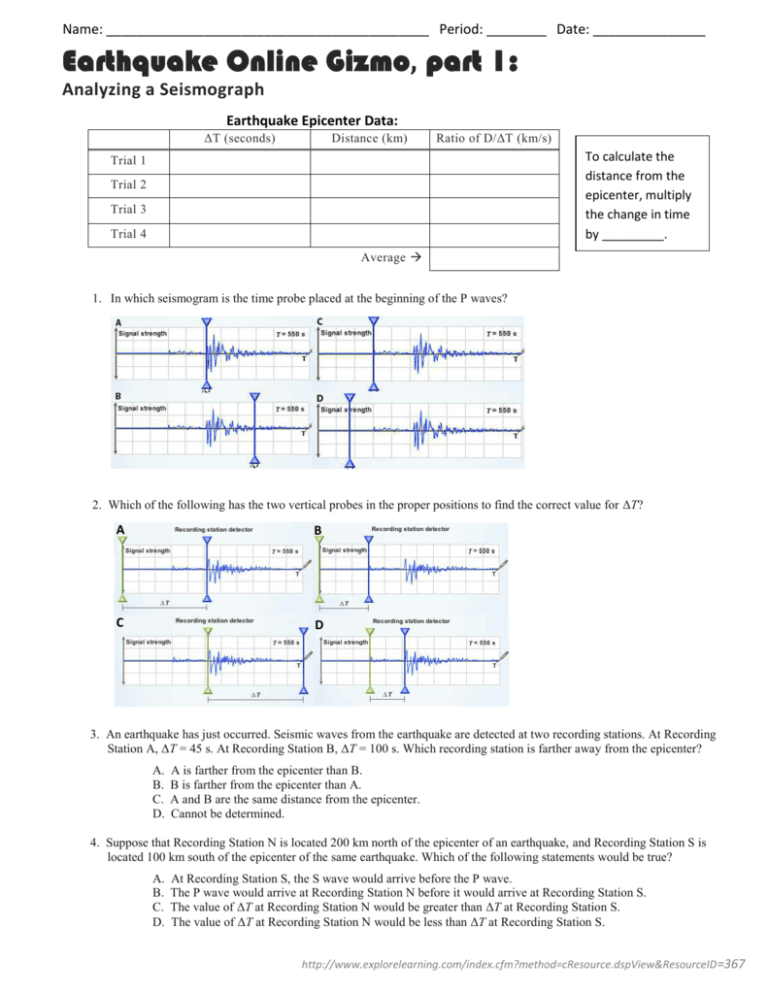
Name: ___________________________________________ Period: ________ Date: _______________ Earthquake Online Gizmo, part 1: Analyzing a Seismograph Earthquake Epicenter Data: ΔT (seconds) Distance (km) Ratio of D/ΔT (km/s) To calculate the distance from the epicenter, multiply the change in time by _________. Trial 1 Trial 2 Trial 3 Trial 4 Average 1. In which seismogram is the time probe placed at the beginning of the P waves? 2. Which of the following has the two vertical probes in the proper positions to find the correct value for ΔT? A B C D 3. An earthquake has just occurred. Seismic waves from the earthquake are detected at two recording stations. At Recording Station A, ΔT = 45 s. At Recording Station B, ΔT = 100 s. Which recording station is farther away from the epicenter? A. B. C. D. A is farther from the epicenter than B. B is farther from the epicenter than A. A and B are the same distance from the epicenter. Cannot be determined. 4. Suppose that Recording Station N is located 200 km north of the epicenter of an earthquake, and Recording Station S is located 100 km south of the epicenter of the same earthquake. Which of the following statements would be true? A. B. C. D. At Recording Station S, the S wave would arrive before the P wave. The P wave would arrive at Recording Station N before it would arrive at Recording Station S. The value of ΔT at Recording Station N would be greater than ΔT at Recording Station S. The value of ΔT at Recording Station N would be less than ΔT at Recording Station S. http://www.explorelearning.com/index.cfm?method=cResource.dspView&ResourceID =367 Earthquake Online Gizmo, part 2: Locating the Epicenter 1. Which of the three recording stations was closest to the epicenter of the earthquake, based on the seismograms shown below? A. Station A B. Station B C. Station C 2. Suppose you have seismograph data from two recording stations for an earthquake. You have calculated the distance of the epicenter from each station, which is indicated with the circles shown below. What do you know about where the epicenter of the earthquake was located? A. B. C. D. 3. Suppose that an earthquake occurs, and the epicenter is 80 km from a recording station with a seismograph. At that recording station, how much time will pass between the arrival of the first P wave and the arrival of the first S wave? (In other words, what will ΔT be?) A. B. C. D. 4. The epicenter was somewhere between locations 1 and 2. The earthquake had two epicenters, at locations 1 and 2. The epicenter was either at location 1 or 2. You cannot tell anything about the location of the epicenter. About 8 seconds About 10 seconds About 80 seconds About 640 seconds Two different recording stations have found that they had the same value for ΔT after an earthquake. If this is all the information they have so far, what can they conclude? A. B. C. D. The epicenter is exactly halfway between the two recording stations. The epicenter is the same direction from both recording stations. The epicenter is the same distance from both recording stations. They know nothing about the location of the epicenter until they have data from one more recording. station. http://www.explorelearning.com/index.cfm?method=cResource.dspView&ResourceID=371

